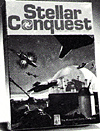
Designed by Howard Thompson
The Avalon Hill Game Company
4517 Harford Road, Baltimore, MD 21214
Release: July, 1985
Catalog No. 859
Price: $24.00
Complexity: Intermediate
Solitaire Suitability: Low
*****
If you long for a chance to conquer the galaxy, Stellar Conquest is just what you're looking for. Two to four players explore an uncharted area of space, establish planetary colonies, struggle with economic development, and engage in interstellar warfare in one of the best science fiction board games ever published. With only six pages of rules, Stellar Conquest is a breeze to learn, but it's a killer to master and is likely to be one of the most replayed games in your library.
Old timers familiar with the original version will be happy to learn that The Avalon Hill Game Company has done its usual superb job of fine-tuning the design and upgrading the components. The 24 x 22 inch, mounted game board shows a small portion of the Milky Way galaxy overlayed with a hex grid and dotted with variously colored stars. Each player receives an identical set of 130 counters in one of four colors, a Task Force Card containing various charts and tables, and a player record sheet to keep track of colony and exploration data along with records of expenditures.
A deck of 78 cards is divided into five sets, each corresponding to a different color of star. W-ien a new star is explored, a card with the same color is drawn which gives information regarding the number of planets, their habitability, and their population capacity. Since much of the game is spent discovering and exploring stars, the cards ensure that their characteristics will be different for each new game.
Each player begins with a fleet of scouts, warships, and colony transports loaded with colonists. He also gets a small number of industrial points, the currency of Stellar Conquest. Scouts are then sent to unexplored stars in search of habitable planets. Once settled, the colonists multiply and begin to produce more industrial points which can be spent on larger fleets or invested in a variety of research projects. As expansion continues, the competition for stars becomes more intense and warfare is inevitable. By successfully balancing expansion, aggression, and development, the player who controls the most stars at the end of 44 turns is the winner.
The number and variety of decisions that must be made every step of the way make Stellar Conquest especially fun. Should you send your ships to a blue star in hopes of discovering a mineral-rich planet (good for rnore industrial points) or should you risk sending a Scout to a more distant (and more desirable) yellow star which may prove to be more habitable? Should you invest in advanced weapons or buy more ships? Should you instigate comhat or avoid it entirely? Each decision can have profound effects on subsequent turns and with a constantly changing set of variables; there is no sure-fire strategy.
The most crucial decisions involve the allocation of industrial points. Players may buy basic fleet units at any time, but more advanced technology requires an investment first. For instance, 25 industrial points invested in Industrial Technology enables the player to buy revenue-producing factories on colonized planets. Twentyfive points invested in Controlled Environment Technology allows colonization of previously uninhabitable planets. Other investments produce faster ships, improved weaponry, and exotic creations such as Robotic Factories and Death Stars. Managing your economy is a real challenge as there are never enough industrial points to buy everything you want, and there are no obvious priorities aside from the essential increased ship speed. Since industrial points are gained only every fourth turn, poor planning can do a lot more damage to your campaign than interstellar war.
Each player keeps track of all his transactions on his record sheet, including discovered data about explored star systems, research investments, and colonization records. The record sheets are not open to inspection by other players, nor are the enemy ship counters which are always inverted on the game board. With players operating independently, they must count on each other for accurate bookkeeping and honesty. Sneaky players or those who flunked arithmetic are unwelcome. Since you can never quite be sure what the opposition is up to, Stellar Conquest maintains a high level of tension from beginning to end.'
Problems with the game are minor. The economic system is, of course, abstract and simplified and is not an accurate simulation in any sense. Role-players may object to the low amount of player interaction and the utter lack of personality in the alien races. And, in addition to the number of stars a player controls at the end, victory points should also be awarded for the number of surviving colonists, but that's probably not in the spirit of a game that casually vaporizes five million people with a single roll of the dice.
Stellar Conquest is a knockout. It's easy to learn and is as much fun the tenth time around as it is the first. There is definitely an emphasis on economic planning, probably more than many space opera fans would like, but the mechanics never get in the way of the playability. If economics were this much fun in real life, a lot more of us would be accountants. Round up a copy of Stellar Conquest and dig in.
More War Game Reviews
-
Game Review: Operation Winter Storm: Stalingrad
Game Review: Ace of Aces Balloon Busters WWI Air Combat Game
Game Review: Carriers at War, 1941-45 Fleet Operations in the Pacific
Game Review: Rolling Thunder Air War Over North Vietnam
Game Review: Operation Market Garden
Game Review: Stellar Conquest
Back to Table of Contents -- Game News #10
To Game News List of Issues
To MagWeb Master Magazine List
© Copyright 1985 by Dana Lombardy.
This article appears in MagWeb (Magazine Web) on the Internet World Wide Web.
Other military history articles and gaming articles are available at http://www.magweb.com